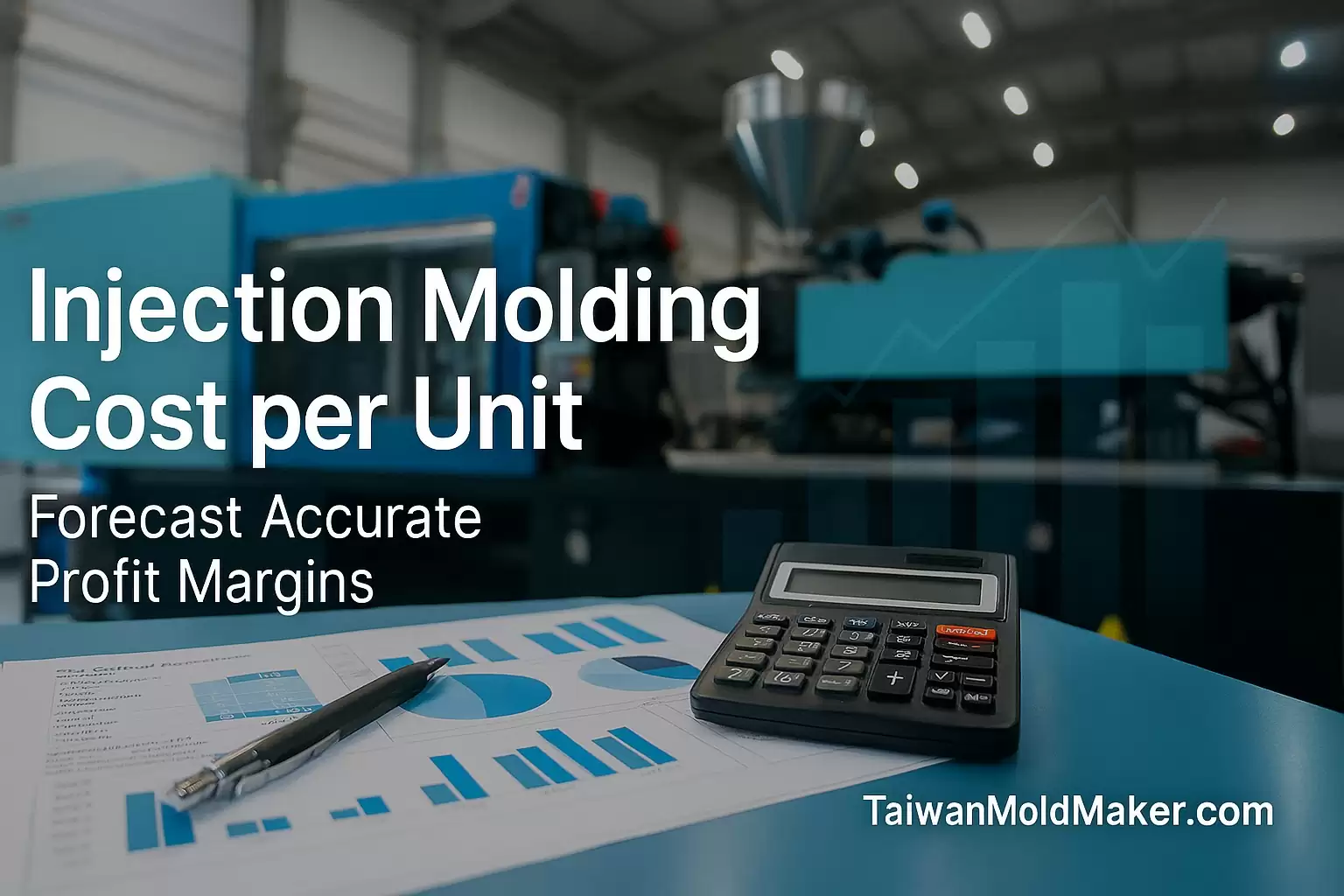Determine Injection Molding Cost per Unit to Forecast Accurate Profit Margins
Determine Injection Molding Cost per Unit to Forecast Accurate Profit Margins
If you can’t trust your cost-per-unit (CPU), you can’t trust your profit forecast. This guide shows a practical, engineering-first method to calculate CPU for injection-molded parts and turn that number into reliable margins—from prototype to mass production. Use it as a checklist, or send your CAD to TaiwanMoldMaker.com for a 48-hour DFM & Cost Pack.
The Cost-Per-Unit Formula (FOB, ex-works)
CPU = Material + Machine Time + Labor + Overhead + Tool Amortization + Secondaries + Packaging + Freight/Duty (if applicable)
What each term means (and how to estimate fast)
-
Material = (Part wt. + Runner wt.) × (1 + scrap %) × (Resin price × blend)
-
Machine Time = Press rate ($/h) ÷ (3600 / cycle time) ÷ cavities × (1/OEE)
-
Labor = (Operators × labor $/h) ÷ parts/hour
-
Overhead = % × (Machine + Labor)
-
Tool Amortization = Tool price ÷ program quantity (or expected life)
-
Secondaries = In-cell print/laser, weld, leak-test, assembly
-
Packaging = Bags, trays, cartons, labels, desiccant
-
Freight/Duty = Per-piece share of logistics + any import charges
Tip: Put OEE (Overall Equipment Effectiveness) in the denominator. For stable programs, OEE ≈ 0.85–0.92 is realistic.
Worked Example (4-cavity, PC/ABS housing)
Assumptions
Part 80 g + runner 10 g; scrap 1%; resin $3.20/kg + 3% MB at $6.00/kg; cycle 22 s; 4 cavities; OEE 0.90; press rate $14/h; 0.4 operators at $6/h; overhead 15%; tool $40 000; program qty 400 k; pad print $0.06; packaging $0.04; freight/duty $0.05.
Results
-
Material: $0.299 /pc
-
Machine: $0.0238 /pc
-
Labor: $0.0041 /pc
-
Overhead: $0.0042 /pc
-
Tool amort.: $0.1000 /pc
-
Secondaries + pack + freight: $0.15 /pc
CPU (total): $0.581 /pc
Margin check: At a sell price of $0.78, gross margin = 25.6%.
Price Needed for Target Margin (from the example CPU = $0.581)
| Target Margin | Required Unit Price |
|---|---|
| 20% | $0.726 |
| 25% | $0.774 |
| 30% | $0.829 |
| 35% | $0.893 |
Formula: Price = CPU ÷ (1 − target margin)
Sensitivity: What Moves Your CPU the Most?
Starting from the example above:
| Change | New CPU | Impact |
|---|---|---|
| Resin +15% | $0.623 | +$0.043/pc (material dominates) |
| Cycle 22 s → 19 s | $0.576 | −$0.005/pc (machine/labor dilution) |
| Cavities 4 → 8 | $0.565 | −$0.015/pc (spreads fixed time) |
| Program 400k → 200k | $0.681 | +$0.100/pc (tooling amortization) |
Takeaway: Resin, tool amortization, and cavity count typically drive CPU more than tiny tweaks to press rate.
How to Forecast Accurately (and Defend Your Quote)
-
Lock part weight early. Every extra gram at $3–6/kg compounds across millions of parts.
-
Model real cycle time. Use Moldflow® cooling and conformal inserts; don’t guess.
-
Right-size cavities. Match demand curve; avoid paying for unused capacity.
-
Amortize truthfully. Tie tooling amortization to realistic program volume, not marketing hopes.
-
Include secondaries & pack. In-cell finishing (print/laser/weld) reduces freight legs and surprise costs.
-
Track OEE and scrap. Quote with evidence—shot weight curves, V/P transfer, and MES trends.
-
Stress-test resin price. Quote a ±10–15% resin escalator to protect margins.
What You Get from TaiwanMoldMaker.com
-
48-Hour DFM & Cost Pack (gate, draft, cooling, cycle model, CPU breakdown)
-
Bridge-to-Steel Tool Credits (reduce amortization risk)
-
Live MES Dashboard (CpK, OEE, shot weight, energy per kg)
-
Service-weighted billing options to reduce dutiable value on the tooling portion
-
Inline finishing (pad print, laser mark, weld, leak-test) to keep “all-in” CPU predictable
Quick Links
-
✔️ Mold Service
-
✔️ Molding
Ready to Turn Costs into Confident Margins?
Request an Instant Quote →
Upload your CAD and volume tiers; we’ll return a defensible CPU, sensitivity analysis, and a timeline you can take straight to your CFO and your customer.









